
Fortress Marienberg overlooking the Main River and the famous Würzburger Stein Vineyard
Last Fall, I returned to a wine region I once called home, Franken (Franconia in English). I lived in Würzburg, the heart of the Franken wine-growing region. Here, steep hillside vineyards overlook the Main River. It is in Franken that my appreciation and love of wine began. Franken wines left a lasting impression on my wine-drinking palate. The wines produced here are primarily dry whites; Silvaner is the flagship variety, along with Riesling, Müller-Thurgau, White Pinot varieties, Bacchus, and Scheurebe, among other whites. Due to warming temperatures that help ripen the grapes, the rising red variety is Spätburgunder (Pinot Noir).
Ann Krebiehl MW describes Franken wines perfectly (and why I am a fan) in her book, The Wines of Germany – “Franken wines – Silvaner, Riesling, and Spätburgunder above all – are rarely loud.” They are subtle and nuanced, and therein lies their disarming and enduring beauty. Often slender, they convince with depth rather than power and are just like the landscape, illustrative of the soils.”
Vom Boden, a major U.S. importer of German wines, describes Franken wines as “famously, brutally dry” and “one thing is absolutely crystal-clear about Franconia, though: this is a region to watch.” Vom Boden
My wine and food notes from Franken include visits to two wineries: Weingut Hans Wirsching in Iphofen and Bickel-Stumpf in Frickenhausen.
Where is the Franken Wine-Growing Region
Franken is located in Northeast Germany and lies east of Frankfurt in Bavaria. Most of the 6100 hectares of vineyards are planted on south-facing slopes lining the Main River and its tributaries. Franken is bordered by the Rhön Hills in the north, the Steiger Forest in the east, the Tauber River Valley in the south, and the Spessart Hills in the west.
The region is divided into three districts: Mainviereck (Main rectangle) to the west. Here, the soils are mainly red Buntsandstein (red sandstone). The Franken heartland around Würzburg, Maindreieck (Main triangle), has primarily Muschelkalk soils (shell limestone). To the east, the Steigerwald has a low mountain range further from the Main river with Keuper soils (marl and limestone).

map courtesy of wineguide.wein.plus
Weingut Hans Wirsching, Iphofen

Weingut Hans Wirsching is in Iphofen in the Bereich (district) of the Steigerwald. The estate dates back to 1630. The Wirsching success story begins in 1966 with the brothers Hans and Henrich Wirsching.
Hans (1921-1990) was an accomplished winemaker and cellar master. He is responsible for the trademark style – “fresh, reductive, elegant, and lean.” Heinrich (1933- ) is a visionary and entrepreneur. Together, the brothers invested in prime vineyard locations, steep slopes, and a new production facility. Among the Wirsching vineyard holdings are the esteemed Julius-Echter-Berg, the Kronberg, Kammer, and Kalb.
Today, Heinrich remains the heart of the estate and family. He was even there on the day I visited. Today, his four children partner in the Weingut with Heinrich’s eldest daughter, Andrea, who is heading up the estate as general manager. Dr. Klaus-Peter Heigel is the winemaker. The estate is certified as a sustainable viticulture with “Fair’n Green,” which includes environmental protection, management, and corporate social responsibility. Glyphosate and insecticides are 100% banned from their vineyards, copper and artificial fertilizers. VDP member estate. Weingut Hans Wirsching
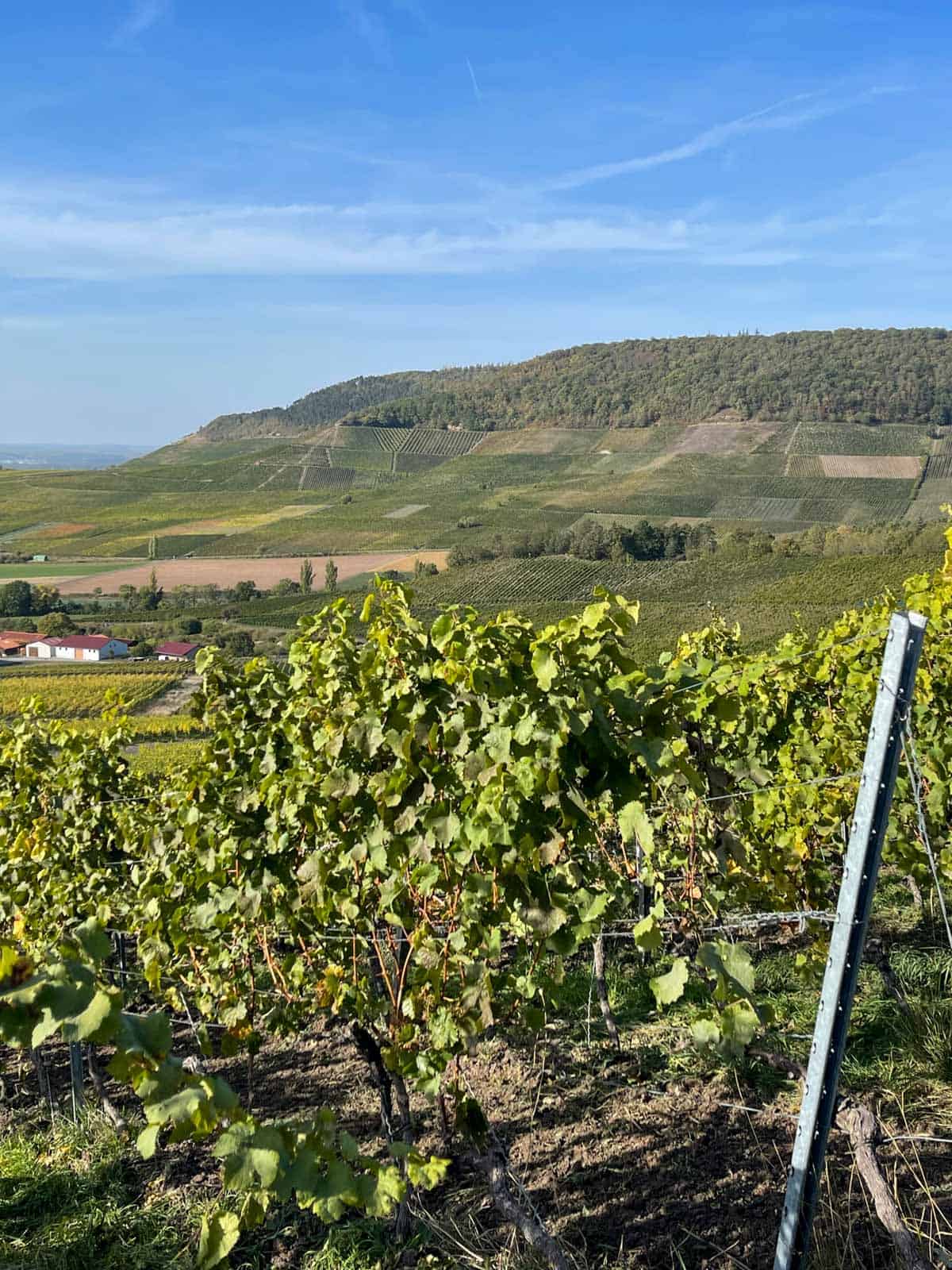
The Iphöfer Julius-Echter-Berg lies on the southwest side of the Schwanberg, a foothill of the Steigerwald. It is the hottest vineyard in Franken with a surface temperature of 70 degrees F. These Grosse Gewächse (Grand Cru) vineyards are south-facing with vineyard altitudes between 280-380 metres.
Wirsching Wines
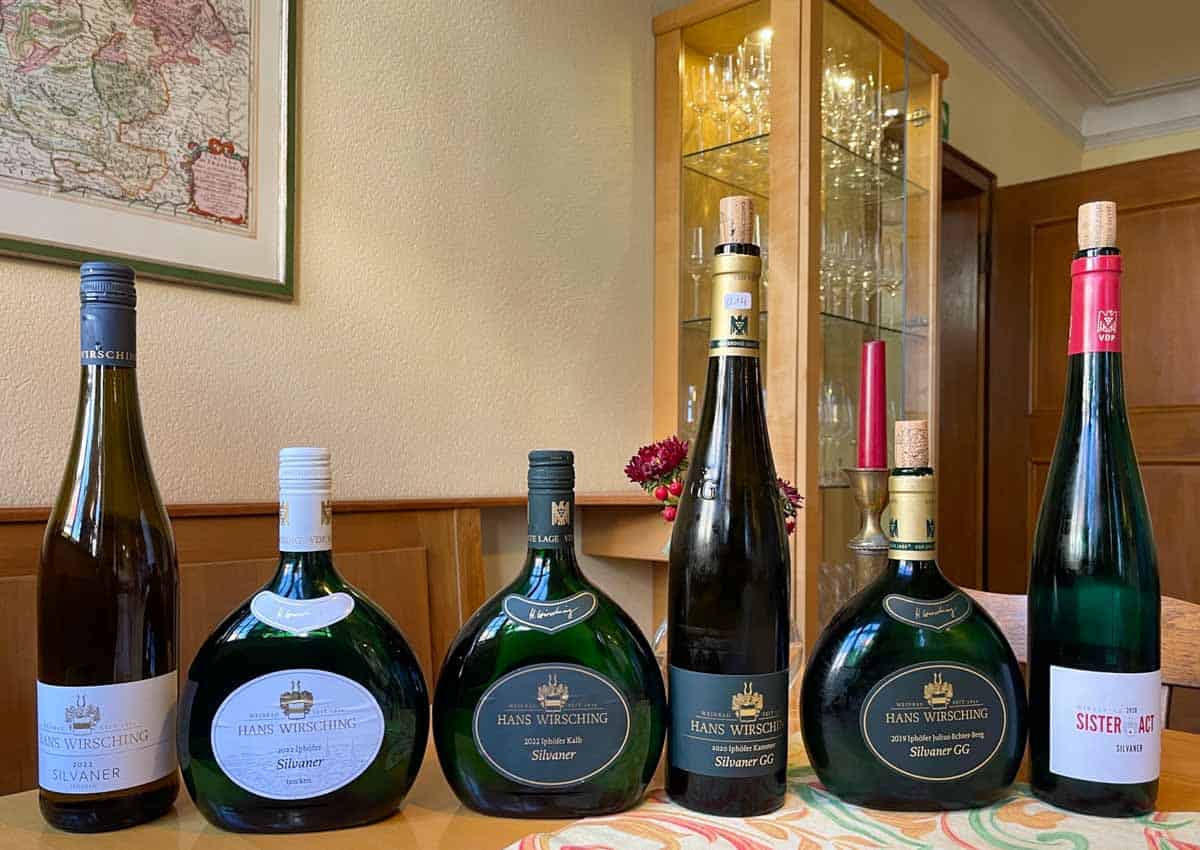
A small selection of the wines I tasted on my visit.
Weingut Wirsching has just under 90 hectares of estate vineyards. A majority of the wines produced are dry whites, including Silvaner (40%), Riesling (20%), Scheurebe, White Pinot varieties (Pinot Blanc, Chardonnay, and Pinot Gris), and about 15% of the wine production is red with a focus on Pinot Noir.
A quote from Wirsching’s website – “Silvaner – the Franconian, Riesling – the finest German grape variety, Scheurebe – the fruity specialty, Pinot – the future.”
Food and Wine Pairing
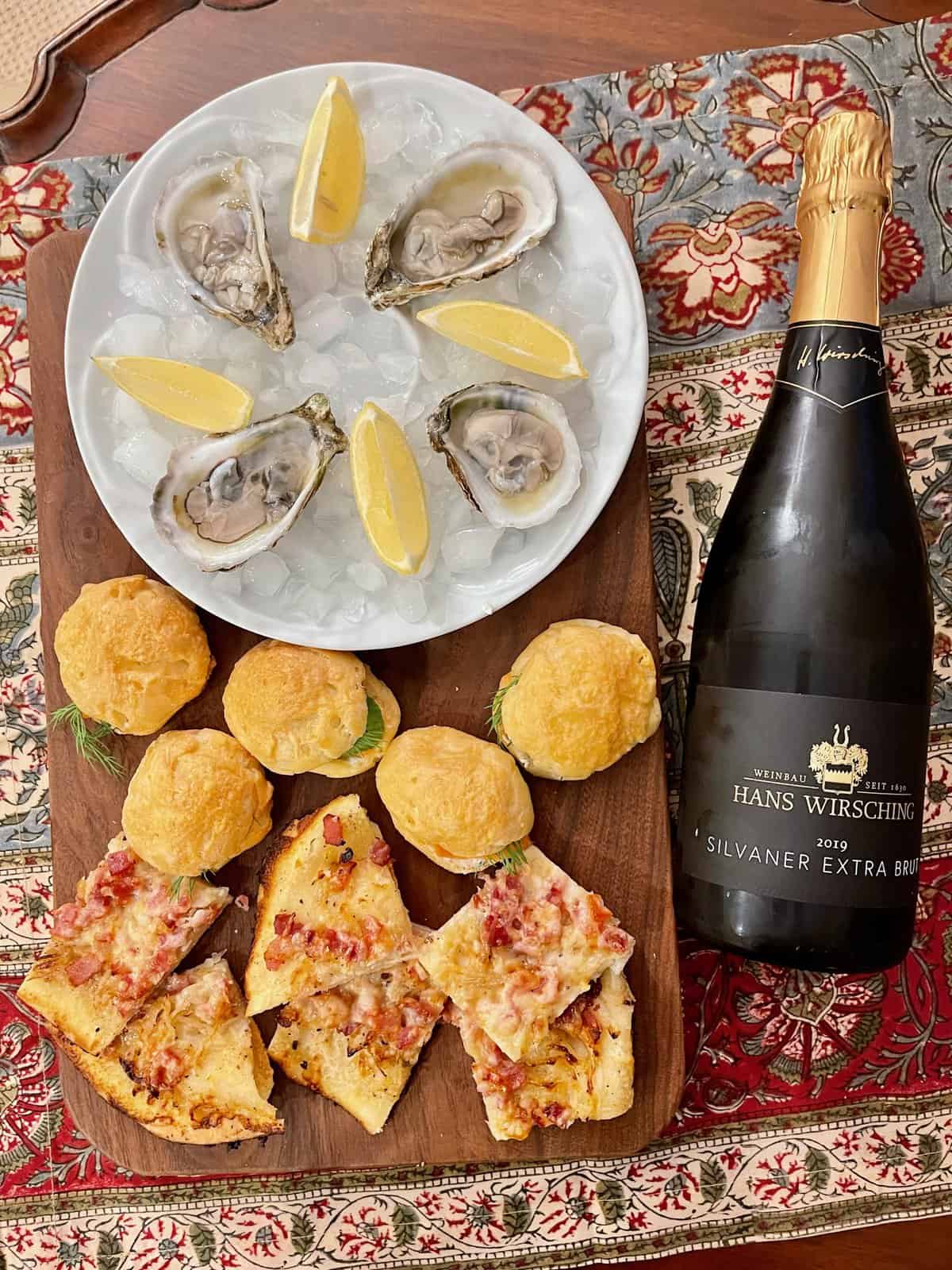
Wirsching currently offers two sparkling wines made using the traditional champagne method. A vintage Silvaner Extra Brut and the 2018 Heinrich Cuvée Prestige celebrating Dr. Heinrich’s 90th birthday.
2019 Hans Wirsching Silvaner Extra Brut
12.5% abv | 18,80 euros (approximately $20.50) | 100% Silvaner
A special cuvée of select Silvaner grapes with 36 months of lees aging in the bottle.
Tasting Notes: The wine is medium golden in color with fresh apple and pear aromas. On the palate, dry, with golden delicious apple and mineral notes and a creamy smooth texture.
Pairings: The perfect food wine. Appetizers of raw oysters highlighting the mineral notes, gougères (cheese puffs) stuffed with smoked salmon, crème fraîche and a fresh dill sprig, and Alsatian tarte flambée with smoky bacon and onion enhancing the brioche notes in the wine. But don’t stop sipping this sparkling with just appetizers; this wine will carry you through a meal of light fish or poultry and mild vegetable preparations with herbs.
Weingut Bickel-Stumpf, Frickenhausen

Matthias and Manuela Bickel-Stumpf
Weingut Bickel-Stumpf is the union of two family wine estates. In 1976, Remund Stumpf from Thüngersheim married Carmen Bickel from Frickenhausen. Both family wineries are located in the Bereich Maindreieck (Main Triangle) but on two different soil types: Frickenhausen on Muschelkalk (shell limestone) and Thüngerheim on Buntsandstein (red sandstone). Bickel-Stumpf’s focus is Silvaner. Tasting their Silvaners from the different soil types is a excellent educational tasting experience.
Today, Carmen and Remund’s son Matthias and his wife Manuela manage the estate. Matthias is the winemaker, and Manuela is in charge of marketing and sales. VDP member estate. Weingut Bickel-Stumpf
A quote from Matthias Bickel-Stumpf – “For me, making wine is a thrill – and a pride. I want to accompany a product that brings people to the table and brings joy!”

The different soil types of Franken ; (left to right) buntsandstein (red sandstone), muschelkalk (shell limestone), and keuper (marl and limestone)

Vineyards overlooking Thüngersheim
Bickel-Stumpf Wine Tasting Notes

2019 Bickel-Stumpf Mönchshof GG, Frickenhausen
13.5% abv | 36,00 euros (approximately $39.00) | 100% Silvaner
The south-facing Mönchshof vineyard is located on the steep slopes of the Main River at the edge of Frickenhausen. The light shell limestone soils reflect the sunlight and heat into the vines.
The wine is pale straw in color. Aromas of herbs, stones, pear, and lime. A rich mouthfeel on the palate with pear, Mirabelle, lime, minerals, and candied citrus peel. The finish is long with a clean elegance.
2019 Bickel-Stumpf Rothlauf GG, Thüngersheim
13.5% abv | 36,00 euros (approximately $39.00) | 100% Silvaner
The Rothlauf vineyard takes its name from a small gully at the steepest part of the Thüngersheim Johannisberg. The stony shell limestone soils are intermixed with the red sandstone that appears randomly at the surface. Here two geological formations from the Franconian Triassic period can be found side by side.
Pale straw in color. On the nose, aromas of herbs and minerals. On the palate, fine fresh acidity with a smooth mouthfeel and flavors of minerals, herbs, and lime. The finish is lean but elegant.
Food Pairing
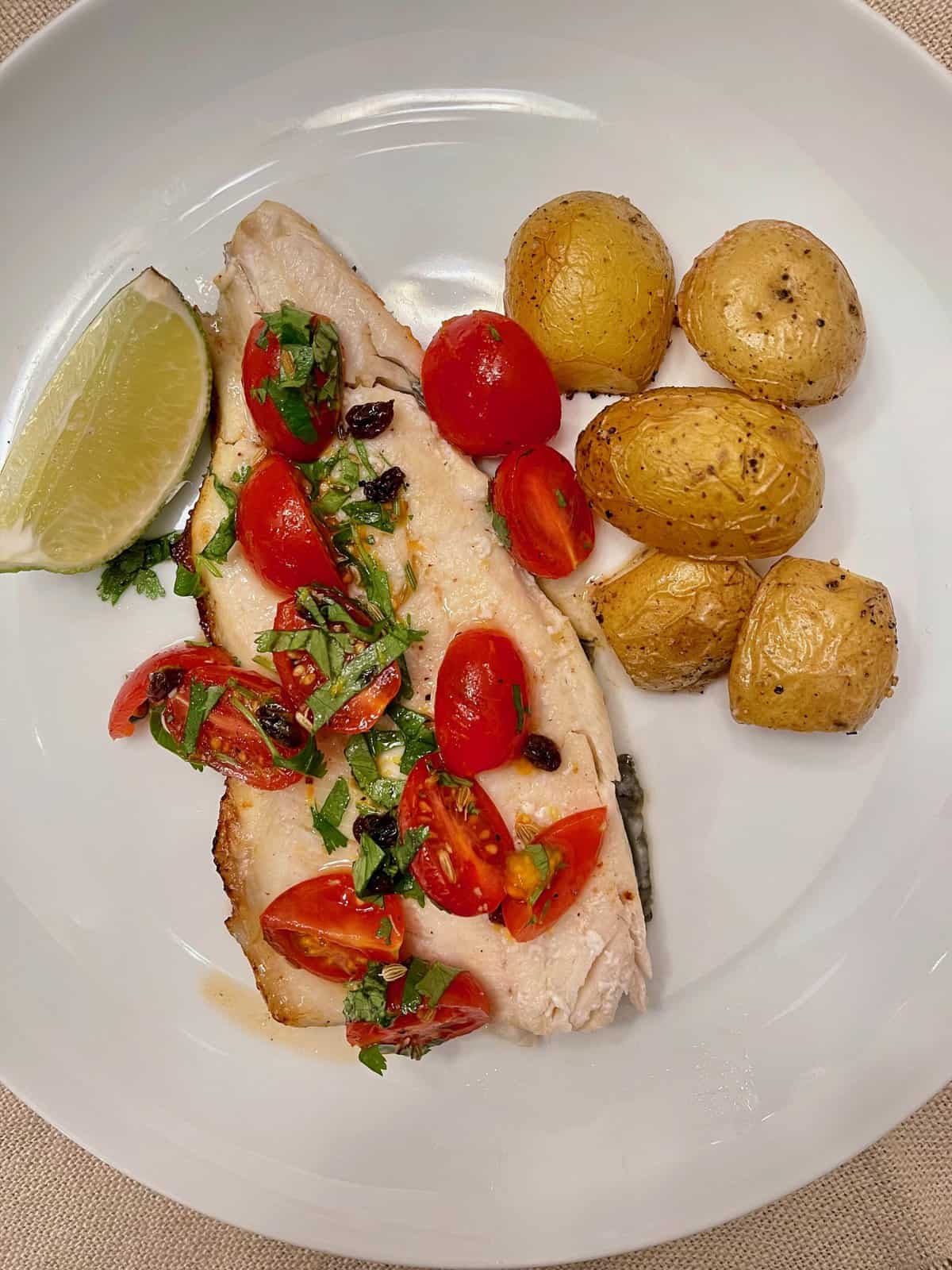
I paired the Bickel-Stumpf Silvaners with a roasted trout with tomato, orange, and currant salsa. The trout complimented the wines with a similar weight, citrusy notes, a hint of sweetness, and earthy elements. Both Silvaners made for a lovely pairing with the trout – my favorite was the richer mouthfeel, mineral Mönchshof Silvaner.
Roasted Trout with Tomato, Orange, and Currant Salsa
Ingredients
- 6 oz. cherry tomatoes, halved
- 1 small organic orange, zested for 1 teaspoon and juiced for 1 tablespoon
- 2 organic limes, 1 lime juiced for 1 tablespoon and the 2nd lime cut into wedges for serving
- 1 teaspoon maple syrup
- 2 tablespoons currants
- 2 tablespoons fresh lemon juice
- 1½ teaspoons fennel seeds, lightly toasted and crushed or fennel pollen
- 1 tablespoon extra virgin olive oil
- salt and pepper
- 5 tablespoons unsalted butter
- 1 medium gralic clove, peeled and crushed
- 2 whole trouts, gutted and scales (about 1½lbs. total)
- 1/2 cup fresh cilantro leaves, roughly chopped
Instructions
- Preheat the oven to 475℉.
- Soak the currants in the lemon juice for 10-15 minutes.
- In a medium bowl combine the tomatoes, orange zest, orange juice, lime juice, maple syrup, currants, fennel seeds, olive oil, 1/8 teaspoon salt, and a few grindings of black pepper. Mix and set aside.
- In a small sauce pan, warm the butter with the garlic over medium heat until the butter is melted.
- Arrange the trout on a rimmed baking sheet, spaced apart. Season the trout on both side and in the cavity with 1/4 teaspoon salt for each. Pour the melted butter and garlic over the trout making sure all sides and the cavity are covered. Roast the trout, closed in the oven for 18-20 minutes, basting once, until the fish is just cooked.
- Stir the cilantro into the salsa.Serve the trout with oven roasted potatoes and spoon some of the salsa over each trout.
Sources Used:
Weingut Hans Wirsching
Weingut Bickel-Stumpf
“The Wines of Germany,” Anne Krebiehl, MW
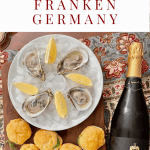
Loved reading this Jane. I do not drink enough German wine. Your food looks amazing as always.
Thanks Cathie! The Franken wines are dry and the Pinot Noir (Spätburgunder) is an amazing value.
So nice to see this lovely blog again! I’ve missed it! Your food looks delicious (especially the oysters)…Must share with my German friend Annie!
Oh Tina, I did not know you are an oyster fan. I would love to know if your friend is familiar with Franken wines.
It’s been a long time since I’ve tasted Scheurebe and tasted any Franken wines. I’ve only driven through the region to Baden-Baden. Would love to hear more about your time there. Love the simplicity of your tasty looking trout!
Actually I tasted my first Scheurebe at Wirsching last fall. Are you a Scheurebe fan?
Trout is often on the menu in the Franken region. The preparation is different in Franken but the recipe I made is an easy week night meal or (lazy weekend) and so delicious with Silvaner.